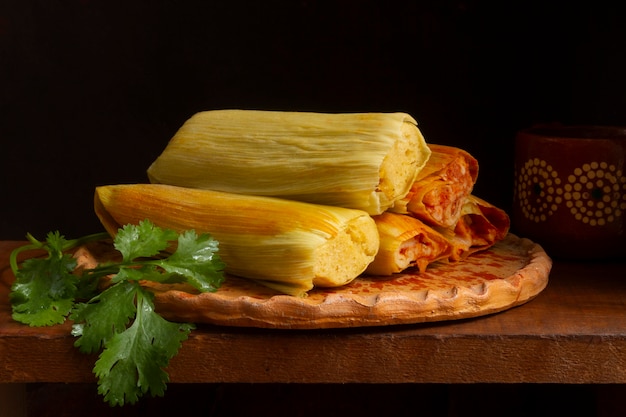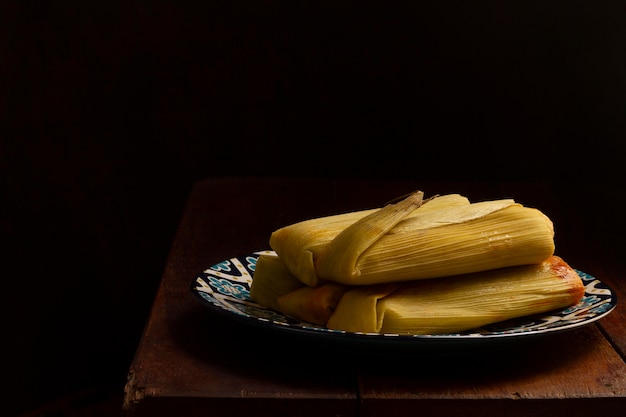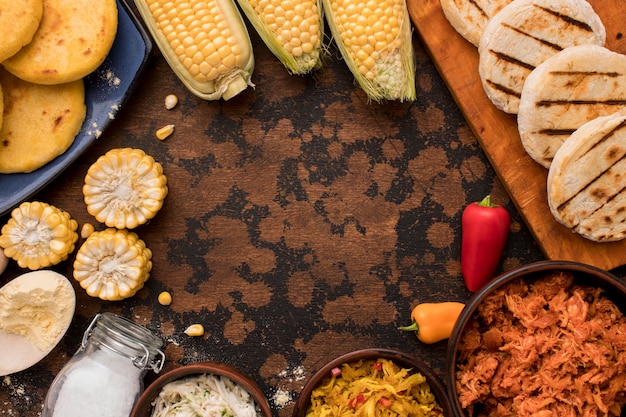Ah, tamales. Those little bundles of joy, bursting with flavour and wrapped in fragrant corn husks. They're the star of any gathering, disappearing faster than you can say "??Buen provecho!" For years, I've been making my own tamales, and I've learned a thing or two about the art of steaming them to perfection. It's not just about throwing them in a steamer and hoping for the best. There's a delicate dance involved, a symphony of timing and heat, to achieve that perfect, fluffy masa and perfectly cooked filling. Let me share my secrets with you.
(Part 1) Timing is Everything: The Art of Steaming Tamales

The magic of steaming tamales lies in the balance. You want to cook the masa dough and filling thoroughly, but without drying them out. It's a bit like a tightrope walk, and getting the timing right is crucial. Overcook them, and the masa can turn dry and crumbly, like a forgotten piece of toast. Undercook them, and you'll be left with raw dough and a disappointing filling. We want a happy medium, a balance of texture and flavour.
The Variables that Influence Cooking Time
You see, there's no one-size-fits-all answer when it comes to steaming times. It's like a recipe with a few extra ingredients. Here's what you need to consider:
- Size Matters: Smaller tamales cook faster than their larger cousins. Think of it like a smaller pot of water boiling quicker.
- The Power of the Steamer: A large, robust steamer, churning out a symphony of steam, will cook your tamales quicker than a smaller, less powerful one. It's like having a strong chef versus a hesitant one.
- Masa Thickness: The thickness of your masa dough plays a role too. A thick layer of masa will need more time to cook through, like a thick steak needing more time on the grill.
- Filling Matters: Some fillings, like hearty beans or tender meats, take longer to cook than others. Think of a stew simmering longer than a simple salad.
(Part 2) The Tamale Detectives: Signs of Doneness

Now, how do you know when your tamales are ready to be devoured? It's not just about checking the clock. You need to become a tamale detective, using your senses to uncover the truth. It's a fun little game, and with a bit of practice, you'll be a master.
1. The Look Test: Visual Clues to Perfection
Start with a good look. Your tamales should have a slightly puffed-up shape, like they're happy and content after a good meal. This tells you the masa has expanded, cooked through and ready to be enjoyed. If they're still flat, they need a little more time to relax in the steam.
2. The Feel Test: A Gentle Squeeze for Confirmation
Next, give your tamales a gentle squeeze. The masa should feel firm, not soft or mushy. If it feels a bit too soft, it needs a few more minutes to firm up. It's like a cake, you want it to be baked through, but not overly dry.
3. The Steam Test: The Rhythm of a Good Steamer
Keep an eye on the steam. You should see a good, steady flow, a rhythmic dance of steam, a sign of a happy and healthy steamer. If the steam is weak, it could be that your steamer isn't producing enough heat, and your tamales need a little extra encouragement.
4. The Taste Test: The Final Verdict
Finally, the moment of truth. Take a bite, a little peek inside. The masa should be cooked through, not raw or doughy. The filling should be heated to your liking, no cold spots or surprises. If you're unsure, you can always use a meat thermometer to check the internal temperature of the filling. Most recipes recommend 165 degrees Fahrenheit for a perfectly cooked tamale.
(Part 3) Steaming Times: A Guide for Different Tamales

Alright, let's get specific. Here are some general steaming times for different types of tamales. Remember, these are just guidelines. Adjust the time based on the factors we discussed earlier.
Traditional Mexican Tamales: The Classics
These are the timeless tamales, made with a simple masa dough and a variety of fillings. They typically take 45-60 minutes to steam. It's like a classic dish, taking a bit of time to come together perfectly.
Oaxacan Tamales: Flavourful and Complex
Oaxacan tamales are known for their rich flavours, often featuring complex mole sauces. They usually require a bit more time, around 60-75 minutes, to allow the flavours to meld and deepen.
Tamales with Meats: A Hearty Treat
If you're indulging in tamales with meat fillings, like succulent pork or chicken, give them plenty of time to cook through. Aim for around 1-1.5 hours to ensure the meat is tender and juicy. It's like a slow-cooked stew, the longer it simmers, the more flavorful it becomes.
Tamales with Beans: A Vegetarian Delight
Tamales filled with beans usually cook a bit faster than their meaty counterparts. Plan on steaming them for about 45-60 minutes. It's like a quick and satisfying meal, perfect for a busy day.
(Part 4) Steaming Perfection: A Step-by-Step Guide
For the best results, I recommend using a steamer. It's like having a dedicated chef, working tirelessly to ensure your tamales are cooked evenly and perfectly. Here's how to do it:
- Prepare Your Steamer: Start by filling the bottom of your steamer with water, ensuring it doesn't touch the steamer basket. Think of it like filling a pot for pasta, but you want enough water to produce a steady stream of steam.
- Arrange Your Tamales: Arrange the tamales in the steamer basket, leaving some space between each one. You want the steam to flow freely around them, like a gentle breeze. If you need to, use a steamer insert or a piece of parchment paper to keep them separated.
- Secure the Lid: Close the lid of your steamer and make sure it's tightly sealed, like a treasure chest guarding its precious contents. You want to keep the steam in, creating a little steamy sanctuary for your tamales.
- Bring the Water to a Boil: Turn the heat to high and let the water boil, a sign that the party is about to start.
- Reduce the Heat: Once the water is boiling, reduce the heat to low, creating a gentle simmer, a peaceful environment for your tamales to relax and cook.
- Steam for the Right Time: Steam the tamales for the recommended time, depending on the type of tamales you're making. It's like a timer, ensuring that they cook perfectly.
- Check for Doneness: Once the time is up, check your tamales for doneness using the methods we discussed earlier. It's like a final inspection, ensuring everything is perfect before serving.
- Rest the Tamales: Finally, let the tamales rest in the steamer for about 10 minutes before serving. This allows the masa to set and ensure everything is evenly cooked, like letting a cake cool before cutting into it.
(Part 5) The Importance of Steam Circulation: A Symphony of Steam
Here's the secret ingredient: Steam circulation. It's the invisible hand that ensures your tamales are cooked evenly, reaching every nook and cranny. Think of it as a gentle breeze, carrying the heat and moisture to every corner of your steamer.
Tips for a Happy Steam Flow
- Don't Overcrowd: Leave some space between the tamales, allowing the steam to dance freely, reaching every tamale. Think of it like a dance floor, you want everyone to have enough space to move.
- Invest in a Good Lid: A tightly fitting lid helps to keep the steam trapped inside, like a blanket keeping in the warmth. Make sure it's a good fit for your steamer, creating a cozy steamy environment.
- Keep an Eye on the Water: Make sure there's enough water in the steamer to keep producing steam, a constant flow of energy for your tamales. You might need to add more water during the steaming process, like keeping a fire going.
(Part 6) Avoiding Steam-Related Mishaps: tamale troubleshooting
We all make mistakes, even in the kitchen. Here are some common pitfalls to avoid when steaming tamales:
1. Overcrowding the Steamer: A Tight Squeeze
Overcrowding can lead to uneven cooking, like trying to fit too many people on a small dance floor. Make sure you leave enough space for the steam to circulate freely.
2. Running Out of Water: A Dry Spell
You need enough water in the steamer to produce a steady stream of steam. Keep an eye on the water level, adding more as needed, like watering a thirsty plant.
3. Too Much Heat: A Scorching Situation
Too much heat can dry out your tamales, like cooking a cake too long. Aim for a gentle simmer, a comfortable temperature for your tamales to relax and cook.
4. Neglecting the Doneness Check: A Missed Opportunity
Don't rely solely on the clock, it can be a bit of a fickle friend. Check your tamales for doneness using the methods we've discussed earlier. It's like a friendly reminder to peek in and make sure everything is on track.
(Part 7) Beyond the Steamer: Alternative Steaming Methods
Don't fret if you don't have a steamer. There are other ways to cook these delightful bundles of goodness. It's like finding a different path to the same destination.
Using a Large Pot: A Simple and Reliable Method
You can use a large pot with a tight-fitting lid. Place a trivet or wire rack in the bottom of the pot, like a stage for your tamales. Fill the pot with about an inch of water, then place the tamales on the trivet. Cover the pot and steam for the recommended time. It's a classic method, simple and reliable.
Using a slow cooker: Low and slow cooking
Yes, you can even steam tamales in a slow cooker, a slow and steady approach. Place the tamales in the slow cooker, cover them with a damp kitchen towel to trap the moisture, like a blanket for warmth, and close the lid. Cook on low for the recommended time. It's like a gentle hug for your tamales.
Using a pressure cooker: A Quick and Efficient Method
If you're feeling adventurous, you can use a pressure cooker to steam your tamales, a fast and efficient way to get dinner on the table. Just remember to follow the manufacturer's instructions carefully, like following a map to avoid getting lost.
(Part 8) Solving Steam-Related Problems: A Guide to Troubleshooting
Here are some solutions for common issues you might encounter while steaming your tamales. It's like having a toolbox for any steam-related challenges.
Tamales Are Dry: A Case of Overcooking
Dry tamales usually happen when they're steamed for too long or the heat is too high, like a cake left in the oven too long. Try reducing the cooking time or lowering the heat next time.
Tamales Are Undercooked: A Need for More Time
Undercooked tamales occur when they haven't been steamed long enough. Steam them for a bit longer and check for doneness again, like giving a cake a little extra time in the oven.
Tamales Are Unevenly Cooked: A Lack of Steam Circulation
Unevenly cooked tamales can be caused by overcrowding the steamer, not using enough water, or not circulating the steam properly, like a lack of air flow in a room. Follow the tips we discussed earlier to ensure even cooking.
(Part 9) tamale variations: A World of Flavours
The beauty of tamales is their versatility. They can be filled with sweet or savory ingredients, a blank canvas for your culinary creativity. Here are a few of my favourite variations:
Sweet Tamales: A Delightful Treat
For those with a sweet tooth, these are a delightful dessert. Some popular sweet tamale fillings include:
- Pineapple: A tropical delight with a tangy sweetness, like a sunny day in the tropics.
- Pecan: A classic combination with a nutty crunch, like a warm and comforting hug.
- Strawberry: A fruity and refreshing option, perfect for a summer barbecue.
Savory Tamales: A Satisfying Meal
For those who prefer something more substantial, here are some savory tamale fillings that always hit the spot:
- Chicken and Mole: A traditional Mexican combination, rich and flavorful, like a journey through Mexico's culinary landscape.
- Pork and Green Chile: A spicy and satisfying filling, a burst of warmth and flavor, perfect for a chilly evening.
- Black Bean and Corn: A vegetarian option, packed with protein and flavor, a hearty and satisfying meal.
(Part 10) FAQs: Answers to Your Tamale Questions
Here are some frequently asked questions about steaming tamales. It's like a little FAQ session, clearing up any confusion and making your tamale journey smooth and enjoyable.
1. Can I Steam Tamales in a Microwave?
While you can technically steam tamales in the microwave, it's not the ideal method. The microwave will cook them unevenly, like a rushed bake, and can dry them out.
2. How Long Can I Store Cooked Tamales?
Cooked tamales can be stored in the refrigerator for up to 3 days, a little taste of heaven for later. You can also freeze them for up to 3 months, a frozen treasure trove of deliciousness. To reheat frozen tamales, steam them for 20-30 minutes. It's like bringing them back to life.
3. Can I Make Tamales Ahead of Time?
Absolutely! You can definitely make tamales ahead of time. Simply assemble the tamales and wrap them in the corn husks or banana leaves. Store them in the refrigerator for up to 24 hours before steaming, a little bit of planning ahead for a delicious reward.
4. What Happens If I Overcook My Tamales?
Overcooking your tamales will result in dry and crumbly masa, like a forgotten piece of toast. The filling may also become overcooked and dry. It's like a little warning to keep an eye on the clock and avoid overdoing it.
5. How Do I Know If My Tamales Are Done?
We've already covered this, but it's worth repeating! Check the tamales for doneness by looking for a slightly puffed-up shape, feeling for a firm masa, checking for steam, and tasting to ensure the masa and filling are cooked through. It's like a checklist for perfect tamales.
(Part 11) The Joy of homemade tamales: A culinary adventure
Making tamales can be a bit of a journey, but it's so rewarding. There's something special about gathering around the kitchen table, sharing stories and laughter, and enjoying the fruits of your labour. It's a bonding experience, a celebration of family and friends. And let's be honest, nothing beats the taste of a homemade tamale, a burst of flavour and love in every bite.
So next time you're planning a get-together, consider making a batch of tamales. Your friends and family will thank you for it. It's a little bit of magic, a little bit of love, and a whole lot of deliciousness.
Happy steaming, and bon appétit!
Everyone is watching

How to Cook Frozen Lobster Tails Perfectly: A Step-by-Step Guide
RecipesLobster. Just the word conjures up images of lavish meals, special occasions, and a taste of luxury. But let's...

Pigs in a Blanket Cooking Time: How Long to Bake for Perfect Results
RecipesAh, pigs in a blanket. Just the name conjures up images of those delightful little parcels of crispy pastry en...

Pork Fillet Cooking Time: How Long to Cook It Perfectly
RecipesPork fillet, or tenderloin as it's sometimes called, is a real favourite in our house. It's so versatile, and...

The Ultimate Guide to Cooking Delicious Frankfurters
RecipesLet's face it, we all love a good frankfurter. It's a classic, simple, and always satisfying. But let's be rea...

Wolf Meat Recipes: A Guide to Cooking Wild Game
RecipesLet's be honest, you don't see wolf meat at your local butcher shop every day. It's a bit of a wild card, but ...
